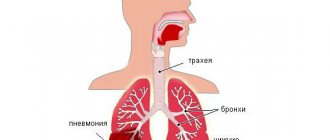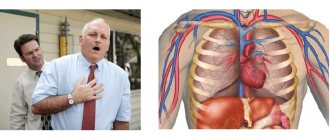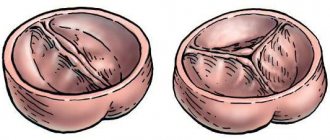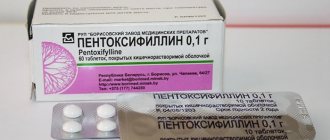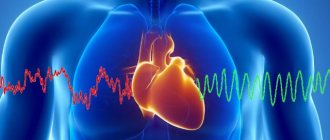Sore throat is an insidious disease. It manifests itself immediately with high fever, sore throat, and after removing the main symptoms, various complications often arise. Doctors have long known that angina affects the heart.
Important! The most vulnerable organs to this disease are the heart muscle and joints, and other human organs also suffer.
Instant complication on the heart muscle
An immediate complication, a concomitant pathology that develops even before the end of the acute period of tonsillitis, as well as immediately after it, is infective endocarditis.
Infectious endocarditis is inflammation of the valves of the heart muscle. Develops due to the sedimentation of active streptococci on the valves. The result of sedimentation is the destruction of the structural elements of the body’s “motor” due to the spread of streptococci. The pathology is called acquired heart disease when the aortic valves are destroyed.
Causes of complications
The effect of angina on the heart does not depend on the age or gender of a person, and in some cases it happens that for the time being there is no suspicion of emerging heart problems.
Heart problems occur for the following reasons:
- Genetic predisposition, stress, non-compliance with sanitary standards, poor nutrition.
- Incorrect treatment of sore throat - insufficient dosage of antibiotics (see Which antibiotics to choose for sore throat) or reducing the duration of treatment cannot completely kill the microbe, but only damage its shell, making it less aggressive. As a result, the virus is not completely destroyed in the tonsils and enters the blood and lymphatic vessels, circulating in them, and after 10-14 days the heart hurts after a sore throat, and vascular inflammation may also occur.
- Features of the structure of the causative agent of the disease - about 80 viruses are known that are causative agents of sore throat. But only about 10 of them are “rheumatogenic,” that is, they are similar in structure to the tissues of the kidneys, heart and joint membranes. After they enter the body, the immune system is not able to distinguish them and develop protection, as a result of which an autoimmune process develops, accompanied by inflammation in the above organs.
Rheumatism
This pathology occurs as a consequence of streptococcal tonsillitis. In the human body, some types of streptococci actively multiply, which leads to rapid heartbeat and the development of defects in the main “pump” of our body.
Symptoms
The disease mostly affects the tissues and organs of adolescents and children. You can find out that rheumatism is already developing by the following signs:
- pain in the heart not with a sore throat, but some time after it;
- constant fatigue;
- a person feels weak when he walks, runs, or climbs;
- dyspnea;
- tachycardia;
- noise while listening;
- Ultrasound reveals expansion of the heart muscle.
The danger of the condition is that sometimes rheumatic symptoms do not appear, and the disease progresses asymptomatically.
Consequences, treatment
Adolescence is a critical age for complications of tonsillitis. Often, already in adulthood, changes are identified that begin at the age of 12-15. The most common diagnosis is mitral valve disease. Advanced disease leads to disability or surgical treatment.
Early detection of rheumatoid heart muscle problems allows timely treatment of the disease. Treatment necessarily includes antibiotic therapy, as well as complete rest. No loads should be given. Be sure to follow all doctor's orders.
Therapeutic measures
Treatment of cardiac complications of tonsillitis is carried out in cardiology hospitals. The patient is prescribed strict bed rest for a period of 4-8 weeks. Further therapy depends on the identified diagnosis and has its own characteristics in each case.
Main areas of treatment:
- Removal of infectious agents. The pathogen is isolated using bacterial culture and antibiotics, antimycotics or antiviral agents are used. Sanitize the source of possible infection.
- Taking anti-inflammatory drugs (NSAIDs) until signs of inflammation are confirmed to have disappeared. In complicated cases, glucocorticosteroids are used.
- Antihistamines. To remove the allergic consequences of infection.
- Immunosuppressive drugs.
- Medicines that improve the functioning of the heart muscle. Potassium preparations, ATP, vitamins, and cocarboxylase are used.
If hypertension occurs, medications are used to stabilize blood pressure. Depending on the disease, anticoagulants, antispasmodics, antiarrhythmics, and anesthetics are also used.
After inpatient treatment, the patient continues to receive outpatient treatment, which can last from 6 months to several years. The patient should come for follow-up visits with a cardiologist every 3 months to adjust treatment.
A necessary condition for improving heart function is maintaining the recommended diet - avoiding unhealthy foods, limiting salty and spicy foods, moderate fluid intake, maintaining a balance of proteins, fats and carbohydrates. Restoring the functioning of the heart muscle requires taking vitamins and complying with physical activity standards.
See also
How and with what to treat sore throat during pregnancy in the 1st, 2nd and 3rd trimester
Read
Endocarditis
Pain in the heart with angina can be accompanied by endocarditis - inflammation of the inner lining of the blood-pumping organ, consisting of connective tissue. This is a dangerous disease that is difficult to treat.
Manifestations of pathology
The disease is accompanied by signs and symptoms:
- hyperthermia;
- pain in the cardiac region;
- weakness;
- chills, fever;
- dyspnea;
- weight loss;
- lack of desire to eat;
- A characteristic sign of the disease is the developing thickening of the phalanges of the nails, in appearance they resemble drumsticks.
Sore throat often causes complications on the heart in the form of endocarditis. If tonsillitis is not treated correctly with antibacterial drugs, highly pathogenic pathogens begin to act. This disease progresses in many patients.
Treatment, prognosis of endocarditis after tonsillitis
Inflammation of the inner lining of the heart is a dangerous complication of angina. It is fraught with the development of many inflammatory processes in the cardiovascular system and other organs and systems. Often there are disturbances in the functioning of organs such as the brain, lungs, liver, spleen, nervous system, and blood vessels.
When the type of pathogen is determined, therapy is prescribed. This is necessarily antibiotic therapy: penicillins with aminoglycosides, anti-inflammatory drugs, non-drug methods, surgery.
Why complications arise
The consequences of tonsillitis develop not only in the presence of its acute form. Chronic sore throat is considered more dangerous, as it can cause long-term problems. Getting rid of them is not easy, so you need to know why they develop.
Heart complications after a sore throat appear due to the following reasons:
- lack of normal treatment for a sore throat;
- the use of excessive amounts of antibiotics or erroneous prescription of medications (after a sore throat, their negative effect on the heart is reflected);
- constantly being in a state of stress;
- After suffering from a sore throat, the defenses may weaken, so the body is not immune from other infections that have a detrimental effect on the heart.
If a person has a sore throat, heart complications develop more often if the underlying pathology is not fully treated. This happens when the patient stops taking medications and following doctors' recommendations after the symptoms disappear. The most dangerous are complications after tonsillitis that occur in children aged 3-15 years. But the child’s body, thanks to its high regenerative abilities, can recover faster.
The older a person gets, the more difficult it is to overcome the consequences of a sore throat. If he develops tonsillitis, the heart is affected due to pathogenic microorganisms entering its tissues with the blood.
Is it possible that there are no complications with angina?
Complications can be prevented if you strictly adhere to the rules and recommendations for treatment and the patient’s daily routine.
- Bed rest for sore throat is mandatory. Restoring strength is important during illness so that the immune system can resist attack from viruses or bacteria.
- The use of antibiotics is mandatory! Antibacterial drugs not only benefit humans, but also harm their beneficial microflora. But for angina, they must be used; without them, the risk of complications is too high.
- Drink plenty of fluids. This simple method, which complements treatment, is important as it allows for more intensive removal of pathogenic microbes from the body.
- Vitamin therapy and sports are a preventive measure for the development of complications after tonsillitis.
- After an illness, it is important to think again about preventing relapse. Repeated inflammation of the tonsils is more difficult.
Sore throat itself is not a dangerous disease; it has terrible consequences for the main “motor” of our body - the heart. To prevent complications, it is necessary to treat the disease in time, and also lead an active lifestyle to boost immunity.
How to treat the consequences of a sore throat
The consequences of tonsillitis on the heart must be treated in a hospital; taking medications on your own or at home in this situation is strictly prohibited. If treatment for the consequences on the heart due to tonsillitis is not started in a timely manner, then a condition may develop that is dangerous for the patient’s life.
Treatment involves the use of the following actions:
- The patient must adhere to bed rest for a long time and strictly (up to 60 days).
- The diet needs to be balanced. The consumption of salty foods and liquids is limited, and proteins and vitamins are added.
- Antibacterial treatment helps fight pathogenic bacteria.
- Nonsteroidal medications, antihistamines, and glucocorticoids are prescribed to relieve inflammation and pain, as well as normalize body temperature.
- Medicines with potassium are needed to improve metabolic processes and quickly restore damaged myocardium.
- Antiarrhythmic drugs, anticoagulants, vitamin preparations and painkillers are also part of the comprehensive treatment of symptoms.
Treatment of heart disease after tonsillitis can last up to 6 months or more. The goal of treatment is to normalize heart function. The patient should be examined by a doctor every three months.
Find out what complications can occur after a sore throat.
Angina Action Plan
Chest pain, discomfort, or tightness can be a symptom of both angina and a heart attack.
If it is angina, it should improve after a few minutes of rest or taking medications prescribed by your doctor, such as GTN (glyceryl trinitrate). If you are experiencing a heart attack, your symptoms are unlikely to improve with a few minutes of rest or taking medication.
Step 1: Angina symptoms begin
- If you experience symptoms of angina, stop what you are doing and rest.
- Tell someone how you feel.
- Take your medications.
Step 2: Wait five minutes
- If symptoms do not go away after 5 minutes, take the medication again.
Step 3: Wait another five minutes
- If the symptoms persist, dial 112 and call an ambulance.
If your symptoms have passed, you can continue with your activities.
Important: If your angina becomes more frequent, severe, lasts longer, or occurs when you do very little or rest, contact your doctor within the next 24 hours.
How to identify complications
Instrumental studies and the results of a physical examination (auscultation) can detect cardiac pathology against the background of a sore throat. To identify the connection between symptoms and acute tonsillitis, the patient is interviewed. The medical record is carefully studied. To identify heart complications you will need:
- Ultrasound;
- radiography;
- electrocardiography;
- load and functional tests;
- analysis for rheumatoid factor;
- general and biochemical blood tests;
- MRI or CT;
- radioisotope scanning.
The following changes indicate myocarditis:
- increase in heart size;
- increased levels of C-reactive protein, sialic acid and gamma globulins in the blood;
- expansion of the cavities of the heart;
- positive reaction of inhibition of lymphocyte migration;
- heart rhythm disturbance.
With stenosis of the mitral valve of the heart, the following are found:
- reduction in the diameter of the mitral orifice,
- enlargement of the left atrium and right ventricle,
- right bundle branch block,
- "cat purr"
- clapping first heart sound,
- diastolic murmur
- displacement of the borders of the heart up and to the right,
- rhythm disturbances and changes in the shape of the heart.
The presence of rheumatism against the background of sore throat is indicated by:
- increased titer of streptococcal antibodies,
- positive results of bacteriological culture.
With this pathology, the heart enlarges and the PQ interval on the electrocardiogram lengthens. An increase in ESR, C-reactive protein and leukocytosis are observed.
Stable and unstable angina
Stable angina is when you experience symptoms of angina during moderate physical activity. These symptoms disappear with rest and/or treatment.
Unstable angina is when you experience angina symptoms while doing very little or resting. This can happen to people who have never experienced angina before.
Stable angina may become unstable.
If your angina becomes more frequent, severe, lasts longer, or happens when you do very little or rest, contact your doctor within the next 24 hours. You may need further testing or treatment.
Isolated myocardial damage
Acute tonsillitis leads to inflammation of the heart muscle. This pathology is called myocarditis. It can be focal and diffuse. In the latter case, the entire heart muscle is involved in the process. Myocarditis against the background of angina can be acute, subacute and chronic. The following stages of myocardial inflammation are distinguished:
- infectious-toxic;
- immunological;
- dystrophic;
- sclerotic.
With this pathology the following symptoms occur:
- aching or paroxysmal pain in the heart area;
- sensations of interruption in the functioning of the organ;
- shortness of breath on exertion;
- weakness;
- fast fatiguability;
- increased sweating;
- drop in blood pressure;
- pale skin;
- frequent and arrhythmic pulse;
- bulging veins in the neck area.
With myocarditis, the size of the heart increases. If there is no treatment, heart failure develops. With diffuse myocardial damage, a cough often appears. It occurs during physical activity. In severe cases, such people develop cardiac asthma and pulmonary edema. The outcome of myocarditis is tissue sclerosis.
How dangerous is tonsillitis for the cardiac system?
Problems with cardiac function due to angina appear 1-4 weeks after the symptoms of the main disease disappear. Often problems are caused by chronic sore throat. As a result of angina, the following heart diseases can develop:
- rheumatism , which is caused by streptococci, characterized by an inflammatory autoimmune reflex in various body systems, usually affecting the heart and joints. During rheumatism, cells of the immune system perceive their integuments as pathogenic bacteria. Thanks to this peculiar reaction, the disease occurs in a severe and chronic form;
- myocarditis - an inflammatory process in the heart muscle;
- pericarditis – inflammation in the pericardium (visceral and parietal layers);
- arrhythmia – the rhythm and functioning of the heart is disrupted;
- a defect may develop ;
- myocarditis sometimes leads to the formation of thromboembolism .
Important! Often, these diseases affect children from the age of three, as well as adults under the age of forty.
The main symptoms in the heart due to tonsillitis are as follows:
- there is incessant pain and murmur in the heart;
- shortness of breath develops, which becomes stronger when playing sports;
- limbs swell. If swelling in the legs persists for a long time, then one may suspect that failure is developing in the heart;
- the skin takes on a bluish tint;
- the patient quickly gets tired, ability to work decreases, lethargy and severe sweating develop;
- the temperature sometimes rises to a subfebrile level;
- pulse quickens;
- the skin becomes pale.




